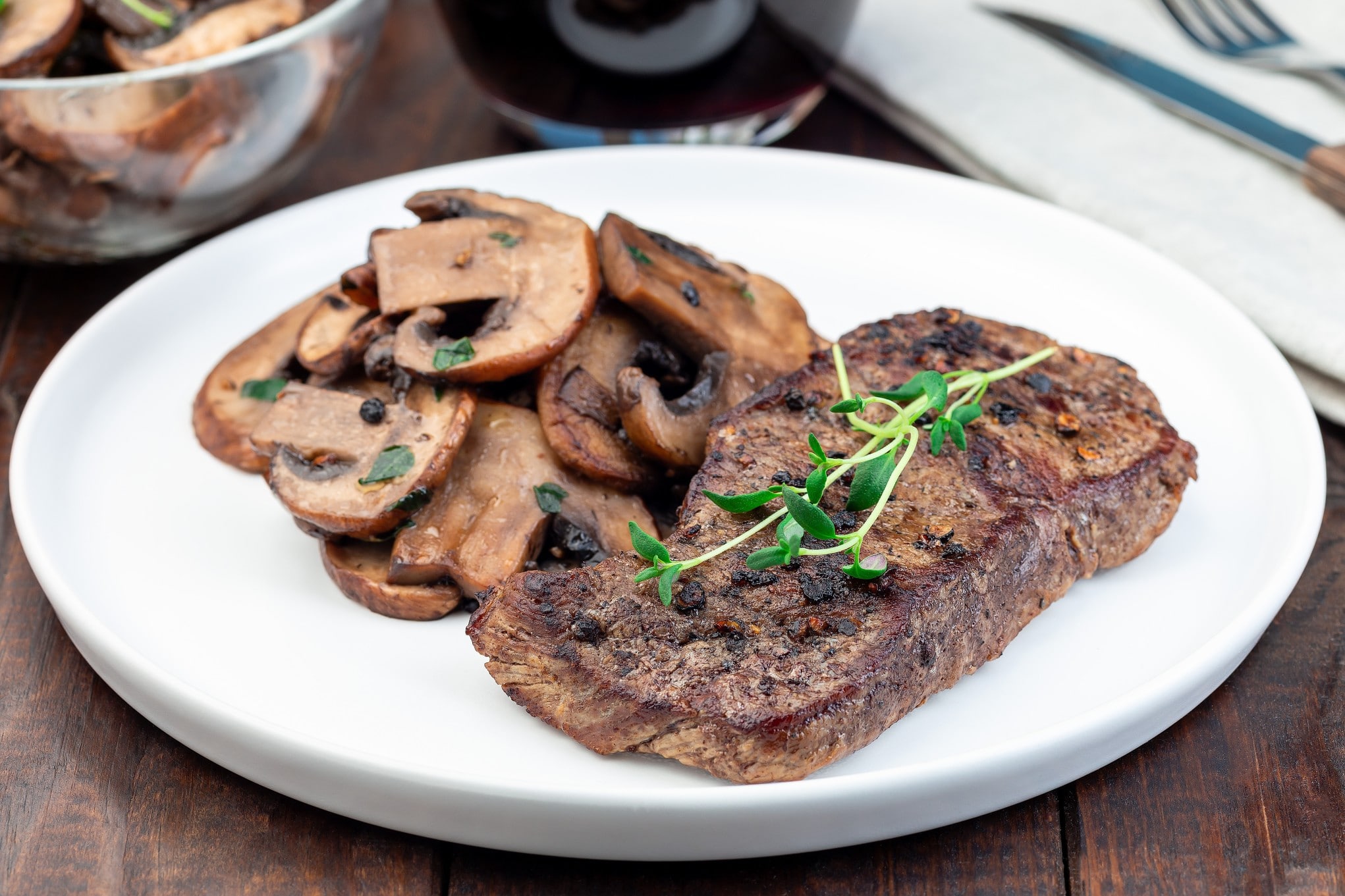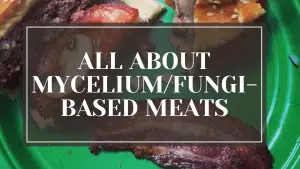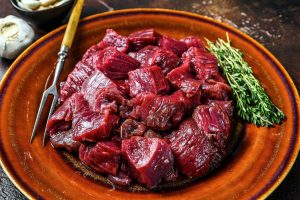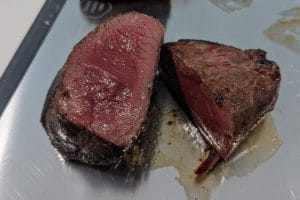All About Mycelium Meat
Important Note: When you buy through our links, we may earn a commission. As an Amazon Associate we earn from qualifying purchases. Content, pricing, offers and availability are subject to change at any time - more info.
Meat production often comes under heavy scrutiny and even criticism for its environmentally damaging nature. That’s why a large number of meat alternatives have become popular in years. Beyond feeding vegans and vegetarians with a safe and healthy form of protein, meat alternatives help to cut back on the potential environmental impact meat may trigger in many areas.
One potentially fascinating and incredibly beneficial alternative meat path is the mycelium/fungal meat market. Though in its early stages of development, this idea already has many in the dietary world buzzing with excitement. Could this be the next prominent meat alternative? Let’s take a look at this topic and give you the insight you need to understand if this is a good choice for you.
- What is Mycelium/Fungus Meat?
- How is Mycelium/Fungus Meat Made?
- Do Mycelium/Fungus Meats Taste Good?
- Who Makes Mycelium/Fungus Meat?
- Why are Company’s Making Fungus Meat?
- How Much Does Mycelium/Fungus Meat Cost?
- Is Mycelium/Fungus Meat Good for You?
- Are There Any Dangers in Mycelium/Fungus Meat?
- Does Mycelium/Fungus Meat Violate Religious or Vegan Standards?
What is Mycelium/Fungus Meat?
Mycelium or fungus meat is a unique meat alternative that utilizes fungal growths to produce a meat-like substance. Now, don’t run away just yet! We know that the idea of literally growing your favorite burger and fashioning it out of a mushroom might seem about as appealing to many as eating a steady diet of earthworms. However, this concept is not as unusual or unexpected as you might think.
This concept has recently been making a lot of progress with certain startups and various market sectors. Fungus-based meat has interested many for years because this food has a dense protein footprint, a surprisingly rich taste, and is very easy to grow. Cutting back on meat production by developing fungus-based alternatives has been seen as a potentially robust solution for global warming and other issues.
As a result, multiple companies (most still within the early stages of development and funding) have been developing mycelium meat over the last few years. Why the use of two terms (mycelium and fungus) to describe this meat? Simply put, the majority of the building blocks for this meat come from the fibers or mycelium found in fungus. Later on, we’ll discuss more about how this process works.
For now, just now that mycelium, fungus, or mycelium/fungus meat all refer to the same item. While different firms may use slightly different methods to produce their product, they’ll more or less all operate similarly. As a result, we won’t break down all of the various techniques used to create this meat alternative but, instead, give you an essential insight into how it works and why it is becoming popular.
You’ll also get the chance to learn more about possible health benefits and even dangers that might occur. We can also give you an insight into what people who’ve tried this meat are saying, as the general public may not have easy access to these products yet. Please note that we also discuss mycoproteins throughout this article, which is the same basic concept as mycelium/fungus meat.
How is Mycelium/Fungus Meat Made?
This production method focuses on the mycelium of fungus, which is a type of thread-forming cell that includes a digestive system on the outside of its cell membranes. Fungus contains a high concentration of these fibers, which grow outside their body and help digest nutrients around them. In other words, as fungus spreads, its surface literally eats nutrients it touches, including any food and water sources.
The process here focuses on creating a large mass of edible fungus and then processing or fermenting their mycelium to build a biomass that can be used to produce various products. Like with soy and other similar meat replacement options, mycelium could be used to make meat, cheese, and many other products. The variety of available alternatives will vary only based on a company’s imagination and skill.
The methods used to produce this product include fermenting various fungi in a controlled environment, carefully removing them from the containment center, processing their fibers, and fashioning them into an edible form. In addition, companies can pack this mycelium with a surprising amount of high-quality vitamins and minerals for your needs by producing a nutrient-rich environment.
Just as significantly, this process naturally cuts back on fat. Thus, fungus meat is naturally fat-free and provides a healthy meat alternative for many people like other meat alternatives. However, it is also true that some may worry about the overall taste of this food. After all, many meat alternatives don’t taste so much like meat but like something that desperately wishes it was meat. So how does mycelium meat stand up?
Do Mycelium/Fungus Meats Taste Good?
Fungus meat is in such an early stage of development that getting an accurate understanding of its taste has been challenging. However, a handful of these startups have provided opportunities for journalists to try their products. For example, one journalist examined the meat of Emergy, a company that has emerged as a potential leader in the field, as they focus heavily on producing a product as close to meat’s taste and texture as possible.
During their research, this journalist discovered that Emergy’s main ingredients used in their product (Meati) contains no natural taste. This tasteless nature has created a unique range of difficulties for fungus meat manufacturers. Simply put, they’ve struggled to produce a product that tastes like something a person would enjoy eating, rather than a very clever scientific experiment gone wrong.
Emergy has tried to approach this process by making fewer than five functional ingredients (including vegetables and spices) to produce a flavor. This combination of ingredients is being kept very secret, though it is continually changing. These natural additives take up 10% of the meat, with the other 90% being made up of mycelium. This journalist got a chance to chomp down on one of these burgers.
Their review was mainly quite favorable. They appreciated the way that the meat seared and crisps like an authentic steak. Biting into the mycelium meat had an overall texture and felt close enough to meat cooked and roasted on a grill. The overall taste was mild and savory but not similar to a mushroom. However, they pointed out that the overall taste was more like a soy nugget than a piece of beef.
The texture was dense and juicy but lacked the kind of connective tissues that make steak and meat so crisp and rich to eat. It wasn’t like biting into a hunk of putty but was less firm than meat. They claimed to have enjoyed the flesh quite well but wondered if it would be enough to convince customers. Most want a meat alternative that not only tastes like meat but feels like meat as well.
That’s one reason why some meat alternatives struggle. They usually look like meat but don’t have the same firmness of texture. The flavors will vary, based on the manufacturer, but can’t ever be genuinely compared to meet. The hope here is that people will appreciate the product for what it is (as many have learned to do with soy alternatives) rather than expecting a one-to-one meat taste and texture feel.
Who Makes Mycelium/Fungus Meat?
A handful of businesses already produce some types of mycelium/fungus meats. These are available in limited amounts in many areas, as are other mycelium/fungal products. The availability will vary based on your location and the different rules and laws in your area. That said, mycelium/fungus meats are still not widely available for mass purchase but for more specialized dietary and eating needs.
In some cases, there are many some companies that are still in the early stages of development and production. However, the sheer number of potential manufacturers buying into this field is fascinating to consider and something that must be understood before any investment. Just a few potential leaders in this possibly soon-to-expand field include:
- Meati Foods – This manufacturer produces fungus meat that feels as close to traditional meat as possible. They are still within the early stages of development and have yet to release any products. They are related to Emergy Foods, as this company is the prominent financier for Meati.
- Nature’s Fynd – Nature’s Fynd has a similar approach to Meati Foods but has made a bit more progress towards release. Few of these companies have yet to release any products, though it is true that mycoprotein-based foods are available in some areas of the world, like in Europe.
- Ecovative Design (AtLast) – Ecovative Design is a unique company focused heavily on funding a variety of ecologically safer materials. Their AtLast line focuses on mushroom-based meat, providing a broad array of different material options for feeding the world.
- La Révolution Champignon – A French startup that uses oyster mushrooms to produce various food alternatives. They use maritime containers to harvest their mushrooms and use the foot as the main ingredient. They focus heavily on sustainability and energy protection.
- Enough – This British manufacturer utilizes multiple types of mushrooms to help replace meat in a way that doesn’t affect the quality of the flesh. Their protein is rich in B12, zinc, and iron and has one of the more fibrous textures of fungus meat, making it an early favorite for success.
- Plantearian – In the US, Plantearian may be one of the leading fungus-based meat alternatives. They produce a zero-waste mycoprotein that combines both wet and dry extrusion processes. Of all the products discussed, this option seems the most meat-like in texture.
- Mushroom-X – Another startup that focuses on mycoproteins derived from mushrooms focuses on creating a meat replacement that doesn’t heavily change the overall manufacturing process. Sustainable methods like these help to create a more vibrant potential market for many.
- Mushroom-X – Based in Hong Kong, this startup is combining various fungus materials and looking to develop nutrient-rich mushrooms that could help to make feeding people healthier and safer. They also utilize mycoproteins to produce biomaterials for construction and much more.
- Mushlabs – Mushlabs operates out of Germany to produce a variety of materials out of mycoprotein. They are particularly interested in minimizing waste and upcycling it into high-value food ingredients. Upcycling refers to taking potential waste and using it for positive production benefits.
- Eastfeed Company Limited – This Chinese company was founded in 1980 as an attempt to reform local farming programs. They have recently turned to produce a variety of meat alternatives, many of them focusing on mycoprotein. They primarily focus on the development of medical products, though.
These firms are all working to develop mycoprotein-based meat sources that could become very popular on the market. Therefore, it is critical to understand their drive towards success and the primary reasons for producing such a product. In addition, doing so can help make it easier for you to gauge when the mass availability of such dining alternatives may be possible.
Why are Company’s Making Fungus Meat?
The surprisingly long list of companies researching and developing mycelium/fungus meat showcases a fascinating reality. Of course, there’s a high potential demand for this type of meat alternative. But what is driving companies to produce it beyond high potential profits? There are at least four reasons why mycelium/fungus meat is likely to become a significant trend in upcoming years.
Sustainability
Fungus is much easier to grow than meat, requiring far fewer nutrients and space to develop. It also grows more quickly, with some firms harvesting fungus daily. Even better, it produces almost no ozone gases, unlike fields of cows chewing the cud. As a result, many companies believe that fungus-based meat may be the future of meat farming, whether the world likes it or not.
Cost
Amazingly, this process is relatively simple and efficient and costs much less than buying, raising, feeding, and butchering cows. By cutting back on production costs, it is possible to provide a suitable and more reasonably-priced dining option than meat. As meat becomes harder and harder to process, experts believe it will become too expensive for the average person to afford easily.
Humane Meat Options
Protests against the cruelty of the meat industry have raged for years. Mass butchering and meat processing create an environmental problem and are treated very harshly and poorly for the animals. Even farms that focus on humane methods come under attack by many people. Fungus feels no pain and hurts no one, providing a much more humane process of preparing meat.
Health Goals
Meat is not always a healthy dietary choice. Fatty meat, in particular, and red varieties can cause heart-related health issues. However, mycelium/fungus meat contains no natural fat, meaning it will be healthier for the average person and (likely) cause minimal health issues.
How Much Does Mycelium/Fungus Meat Cost?
Unfortunately, most fungus-based meats are still in the early stages of development and are not available on the mass market. A handful of European companies are selling products, with prices that vary heavily. You may get costs as low as $4 per pound, though some companies may charge much more. Unfortunately, many of these products are not available in the US, even by import.
That’s because the FDA has yet to approve any of these items, making importing them questionable legally. You may go through extra-legal routes to get this meat but should probably wait until more research has been done and the FDA has approved them. Doing so not only helps to minimize health risks but cuts back on any financial or legal troubles that you may otherwise experience.
Is Mycelium/Fungus Meat Good for You?
Honestly, the potential health benefits of fungus meat are primarily not well understood. There’s simply not enough information about this topic to provide an informed description. However, there are many possible advantages that this meat could provide, including benefits like:
A nearly fat-free design that minimizes weight gain and could help with weight loss as well
High concentration of iron, zinc, and other nutrients make it a high-quality meat replacement
Suppression of appetite thanks to decreased levels of ghrelin caused by a higher protein level.
High levels of fiber could help to improve your digestion and enhance your potential weight loss
Complete protein that helps minimize your risk of deficiency and improve your bodily health
Enhanced physical beauty thanks to better hair, skin, nails, and muscles
Decrease in bad cholesterol and an increase in good cholesterol that helps to make your body healthier
Better sugar control than standard types of meat-based protein, keeping your body healthier
These benefits are all based on the healthiness of mushrooms and the various types of fungus used by these meat manufacturers. Before rushing out to invest in this meat alternative, it is probably best to examine potential dangers that some professionals have recently discussed.
Are There Any Dangers in Mycelium/Fungus Meat?
Although mycoprotein products are available in some limited amounts in the U.S, even in the form of fungus meat, these products have the potential to cause nausea, vomiting, hives, and diarrhea. This issue is known as mycoprotein allergy and is something to be tested for before buying or investing in any of these products. Doing so should minimize any risks that you might otherwise experience here.
This problem is concerning because most people probably don’t realize that they have a fungal allergy because it is so rarely discovered or tested. As a result, some people may just assume that mushrooms don’t “agree with them, which usually means they feel nauseous eating them. When this happens, an unknown allergy is likely the main culprit.
This allergy problem is likely to be the most common concern centered around mushroom-based meats. Manufacturers are attempting to work around this fact but are unlikely to eliminate it. Other than this problem, few common issues are likely to impact mycelium/fungus meat.
Does Mycelium/Fungus Meat Violate Religious or Vegan Standards?
Vegans typically eat mushrooms (as long as they like them) as a great alternative meat source. The only concern would be if insects were caught or injured during the production process. Most of these firms work hard to minimize this risk by cleaning each mushroom and disinfecting them safely. As a result, most vegans should probably be safe eating fungus must.
The same is mostly true for Kosher eaters. Mushrooms are considered kosher and just fine to eat. However, insects are not Kosher and should be avoided. Like with vegans, it is vital to find a company that takes extra steps to minimize the risk of getting insects in their mushroom meat. Thankfully, this shouldn’t be too hard to do, as most strive to meet this goal.
As for Islam and Muslim thinking, mushrooms are not only Halal but looked upon favorably. For example, one teaching states that mushrooms are a “favour which Allah Almighty sent down upon the Bani Isra il,” which is high praise. Moreover, it is called a “fruit of Paradise” and was considered a cure for insanity. As a result, mushroom meat should be very well accepted in most Muslim communities.
Will Mycelium/Fungus Meat Become a Prominent Meat Alternative?
It is challenging to state that fungus meat will become an essential player in the alternative meat industry. First, it is so early in its development that the available products on the market are minimal. Second, just as importantly, FDA approval and other careful studies must be taken to ensure that it meets all of the safety and health guidelines required to be sold on the market.
However, it is fair to say that the sheer amount of money pumped into the industry will likely help it become a surprisingly big player on the field. Therefore, we recommend checking back here to see any news on this fascinating topic. As it develops, we’ll try to integrate updates and various new articles that keep you up-to-date on the latest meat and meat alternatives on the market today.
























